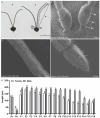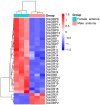The Olfactory System of Dolichogenidea gelechiidivoris (Marsh) (Hymenoptera: Braconidae), a Natural Enemy of Tuta absoluta (Meyrick) (Lepidoptera: Gelechiidae)
- PMID: 40806444
- PMCID: PMC12347633
- DOI: 10.3390/ijms26157312
The Olfactory System of Dolichogenidea gelechiidivoris (Marsh) (Hymenoptera: Braconidae), a Natural Enemy of Tuta absoluta (Meyrick) (Lepidoptera: Gelechiidae)
Abstract
The parasitoid wasp Dolichogenidea gelechiidivoris is a key koinobiont solitary endoparasitoid of the invasive agricultural pest Tuta absoluta. This study investigates both the morphological and molecular foundations of sex-specific olfactory differentiation in this species. Morphological analysis revealed that males possess significantly longer antennae (2880.8 ± 20.36 μm) than females (2137.23 ± 43.47 μm), demonstrating pronounced sexual dimorphism. Scanning electron microscopy identified similar sensilla types on both sexes, but differences existed in the length and diameter of specific sensilla. Transcriptomic analysis of adult antennae uncovered molecular differentiation, identifying 11 odorant-binding proteins (OBPs) and 20 odorant receptors (ORs), with 27 chemosensory genes upregulated in females and 4 enriched in males. Integrating morphological and molecular evidence demonstrates complementary sexual specialization in the olfactory apparatus of D. gelechiidivoris. Linking these findings to the potential functions of different sensilla types, as discussed in the context of prior research, provides crucial insights into the sex-specific use of volatile cues. These findings provide critical insights into the use of volatile signals in this highly relevant species for biological control targeting T. absoluta.
Keywords: Braconidae; Dolichogenidea gelechiidivoris; antennal sensillum; microstructures; odorant receptors (ORs); odorant-binding proteins (OBPs).
Conflict of interest statement
The authors declare no conflicts of interest.
Figures






Similar articles
-
Ultrastructure of antennal sensilla of Anastatus orientalis (Hymenoptera: Eupelmidae), an egg parasitoid of the invasive spotted lanternfly, Lycorma delicatula (Hemiptera: Fulgoridae).Ultramicroscopy. 2025 Oct;276:114179. doi: 10.1016/j.ultramic.2025.114179. Epub 2025 May 25. Ultramicroscopy. 2025. PMID: 40466575
-
Loss of olfaction reduces caterpillar performance and increases susceptibility to a natural enemy.Elife. 2025 Aug 1;14:RP105585. doi: 10.7554/eLife.105585. Elife. 2025. PMID: 40747879 Free PMC article.
-
Can the Combined Use of the Mirid Predator Nesidiocoris tenuis and a Braconid Larval Endoparasitoid Dolichogenidea gelechiidivoris Improve the Biological Control of Tuta absoluta?Insects. 2021 Nov 8;12(11):1004. doi: 10.3390/insects12111004. Insects. 2021. PMID: 34821804 Free PMC article.
-
Characterization of antennal chemosensilla and associated odorant binding as well as chemosensory proteins in the parasitoid wasp Microplitis mediator (Hymenoptera: Braconidae).Sci Rep. 2018 May 16;8(1):7649. doi: 10.1038/s41598-018-25996-3. Sci Rep. 2018. PMID: 29769575 Free PMC article.
-
Pheromone-Binding Proteins in Pest Control: From Molecular Insights to Real-World Applications.J Agric Food Chem. 2025 Sep 3;73(35):21701-21727. doi: 10.1021/acs.jafc.5c03663. Epub 2025 Aug 21. J Agric Food Chem. 2025. PMID: 40836761 Free PMC article. Review.
References
-
- Liu H.X., Liu Z.X., Zheng H.X., Jin Z.R., Zhang J.T., Zhang P.Q. Sensilla on the Antennae and Ovipositor of the Carpenterworm, Streltzoviella insularis (Staudinger, 1892) (Lepidoptera, Cossidae) Orient. Insects. 2018;52:420–433. doi: 10.1080/00305316.2018.1437088. - DOI
-
- Haddad S., Clarke D.J., Jeong S.H., Mitchell R.F., McKenna D.D. Antennal Sensilla in Longhorn Beetles (Coleoptera: Cerambycidae) Ann. Entomol. Soc. Am. 2023;116:83–113. doi: 10.1093/aesa/saac026. - DOI
-
- Lemon W.C., Getz W.M. Neural Coding of General Odors in Insects. Ann. Entomol. Soc. Am. 1999;92:861–872. doi: 10.1093/aesa/92.6.861. - DOI
MeSH terms
Substances
Grants and funding
LinkOut - more resources
Full Text Sources

